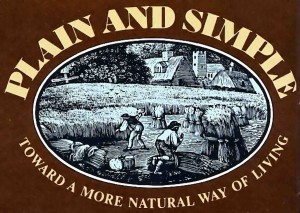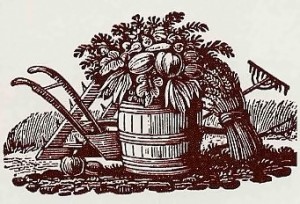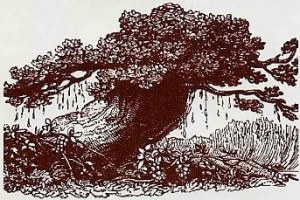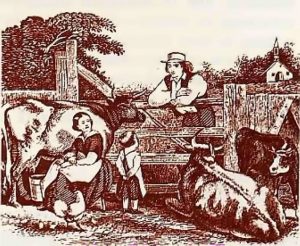Toward a More Natural Way of Living
Ecologists have long urged us to switch from heavy technology back to farming—”back to the land.” But, wouldn’t you know, certain other people insist farming depends on technology… Where do we go from here?
by Rupanuga dasa
 In a resurging interest in farm life, many people are taking to homesteading For the most part, they seem motivated by desires for freedom from high-priced food and public utilities, or perhaps by a desire for peace of mind and God consciousness (both customarily sought in the comparatively peaceful atmosphere of the country). People of all ages, especially young people, are investigating country life as a way around dependence upon oil and machinery and the health hazards of artificial fertilizers and insecticides. These new farmers are inclined toward “do-it-yourself’ inventions and organic gardening. And the dozens of publications dedicated to these ideals give us some indication of just how popular they are becoming.
In a resurging interest in farm life, many people are taking to homesteading For the most part, they seem motivated by desires for freedom from high-priced food and public utilities, or perhaps by a desire for peace of mind and God consciousness (both customarily sought in the comparatively peaceful atmosphere of the country). People of all ages, especially young people, are investigating country life as a way around dependence upon oil and machinery and the health hazards of artificial fertilizers and insecticides. These new farmers are inclined toward “do-it-yourself’ inventions and organic gardening. And the dozens of publications dedicated to these ideals give us some indication of just how popular they are becoming.
Ironically, though, while people are looking to the country for a simpler, more natural way of living, the owners of “agribusinesses” (sprawling farm complexes) and the manufacturers of farm equipment are convinced and trying to convince the rest of us that farming depends on technology.
One national advertisement by a farm machinery manufacturer depicts the historical development of farming techniques, leading up to the phenomenal modern harvests. The first illustration shows a single man in a corner of a field cutting small amounts of grain by hand with a scythe. He represents the earliest, “primitive” farming methods. The second illustration shows a man driving a horse-drawn machine, indicating how much more could be accomplished using animals. The third illustration pictures an early tractor in operation, and the series ends with a photograph of a giant, modern tractor silhouetted against a blue sky and endless fields of perfectly cut grain. The tractor is replete with a wrap-around windshield, radio, air conditioning, and padded dash.

But if the first illustration were expanded beyond the close-up of the lone man in one corner of the field, we would see a whole field of men working together with scythes, very much as they still gather bundles of grain in parts of India. In America the process of urbanization has brought nearly all the descendants of those people who formerly worked in the fields with scythes, horses, and oxen into an economic dependence upon a comparatively small number of farmers using sophisticated machinery. Unscrupulous business practices by food processing conglomerates, inflated living costs, a scarcity of honest labor, bad weather, an exodus of young people to the cities, and the high cost of machinery and artificial fertilizers have forced many owners of smaller farms to exploit the land for as much yield as possible, as soon as possible, as often as possible. Yet the numbers of farms going out of business indicate that it still costs too much to produce too little.
The latest federal Agriculture Department figures show that between 1954 and 1974 the United States farm population dropped more than 50%—until today only about 10 million people (out of a nation of more than 200 million) live on farms. In addition, although the total farmland remained at about one billion acres, the number of farms dropped almost 42%. In fact, since the 1940s the number of farms has decreased by three million, and it continues to drop by two thousand per week. Clearly, “agribusiness” is gobbling up the small- and medium-size farms.
This “to-the-hilt” exploitation of land resources has brought the ecological movement of the 1970s down on automated, high-yield farming, the kind that depends almost entirely upon chemical fertilizers. One may argue that such chemicals are, after all, also a part of nature, and that scientists are simply using them in a more advantageous way. However, studies indicate that prolonged use of chemical fertilizers designed to increase soil nitrates creates an artificial dependence on the chemical itself: the chemical fertilizers kill the myriad microorganisms and earthworms in the soil that naturally produce such nitrates.
Initially there may be “bumper” crops, if climatic conditions are good; but eventually the soil loses fertility. And the long-range leaching effect can be disastrous. Wes Buchele, Professor of Agricultural Engineering at Iowa State University, describes the situation in no uncertain terms. “We’ve lost one-half of the country’s topsoil since we started farming here.” Perhaps the fledgling back-to-the-land movement is more than the desperate attempt of a few oversensitive malcontents to escape city life. Perhaps it’s the first indication of an agricultural movement that can avert ecological catastrophe.
Let’s look at the historical background of modern agricultural techniques:
Forshadowing the massive introduction of chemical fertilizers were the theories of nineteenth-century German chemist Baron Justus von Liebig, who in 1840 published an essay entitled “Chemistry in Its Application to Agriculture and Physiology.” His idea was that when a living plant is incinerated and all its organic matter destroyed, the mineral salts remaining in the ashes will contain all that’s required for its growth (basically potash, nitrates, and phosphates.) Other scientists and agriculturalists concluded that simply adding these chemicals to the soil would maintain its fertility.
Although this conclusion apparently oversimplified ages of agricultural practice, the observable results were impressive. Artificial fertilizers composed of the above chemicals and calcium oxide (lime) produced good initial crops—which seemed to verify Liebig’s experiments. This apparent breakthrough led to the astronomical fertilizer production now so lucrative for the chemical industry. Typically, whenever a farmer has a soil test made on his fields, if the laboratory report indicates deficiencies of phosphate, lime, and so on, he receives a formula of chemicals. He then adds them to the soil to correct the imbalance. Here we have the basis of the prevalent belief that “you get out of the soil what you put into it.”
However, this conclusion came into question a few years ago, when the French agricultural bulletin “Nature et Progres” disclosed a startling experiment. A researcher reported that every month for one year, he had monitored two identical soils—one to which only fermented compost had been added, and one to which an organic mixture rich in phosphorus had been added. At the end of the year, the first sample contained one-third more phosphorus than the second sample, the one to which phosphorus had originally been added.
Thus, soil itself can produce phosphorus without any external supply of this mineral. The researcher called it “a miracle of the living soil!” One wonders where the phosphorus in the first sample came from, since none was added before or during the experiment. After all, chemists have learned that it’s impossible to create new elements or transform one element into another (that is, to alter an element’s atomic structure) simply by chemical reactions. At the same time, many scientists still believe that all reactions occurring in nature are in fact simply chemical—or, in other words, that life comes from chemicals.

But this conviction came under fire from another chemist, Albrecht von Herzeele, who in 1873 performed some experiments that were subsequently ignored. Von Herzeele demonstrated that seeds sprouted in distilled water, with nothing added but air, increased their content of elements like sulphur, calcium, and magnesium (although the law of conservation of matter holds that this is impossible). This experiment proved that plants can continuously create matter as well as absorb matter from soil, water, and air. Von Herzeele claimed that plants could also transmute or change one element into another (such as phosphorus into sulphur, and so on).
In 1958, after ten years of experiments, Professor Pierre Baranger, director of organic chemistry at the Ecole Polytechnique, in Paris, announced his verification of Herzeele’s work to a distinguished gathering of scientists at Switzerland’s Institut Genevois. By 1963 he had demonstrated that as leguminous seeds (like those producing common alfalfa and clover hay) grow in a manganese-salt solution, iron replaces the manganese. In time he explained more about such germinations, including the exact lunar phases that affected them. Baranger concluded that plants are constantly producing chemical transmutations of elements—without the enormous energy of modern “atom smashers,” which till then had been the only known means for transmuting one chemical into another.
Louis Kervran, another French scientist, also contends that lunar phases are extremely important in the germination of crops, and that by transmutation, microorganisms maintain the balance of elements in the soil. He concludes that transmutation results from enzymes that act as catalysts for the reaction. Kervran points out that enzyme activities are biological in origin, not chemical (although the results may be chemical); thus, the classic laws of chemistry do not apply to these phenomena. In other words, he contradicts the assertion that life comes only from chemical combinations. Kervran notes in his “Biological Transmutations” (1962) “that matter has a property so far unexplained by modern science.”
In his book The Nature of Substance (1968), Rudolf Hauschka further hints that this property of matter is its dependence upon life, that chemicals constantly come from life, and that life comes from life (not from chemicals, not from matter). Having duplicated many of Herzeele’s experiments, Hauschka concludes that life is not the result of a combination of elements, but that it precedes the elements: “It is logical to assume that life existed long before matter and originates in a preexistent spiritual cosmos.”

The first Western scientist to demonstrate the real importance of life activities in agriculture was Sir Albert Howard, who at the turn of the century was the imperial botanist to the Indian government. Beginning in Pusa, Bengal, and continuing for forty years in other parts of the subcontinent, Howard managed several experimental agricultural stations. His famous book An Agricultural Testament (1943) inspired a surgeon named J. I. Rodale to begin the organic farming movement in the United States, during the early 1940s. By following the ancient methods of Indian farmers—who regularly aerated the soil, used no artificial fertilizers or pesticides, and returned accumulated cow manure and compost to the land—Howard virtually eliminated disease from both soil and animals. Also, he managed dairy cows and kept oxen for plowing. He wrote, “With no chemical help from science, and by observation alone, he [the Indian farmer] has in the course of ages adjusted his methods of agriculture to the conservation of soil fertility in a most remarkable manner… For countless ages he has been able to maintain the present standard of fertility.”
In typical empiric fashion, Howard attributed the remarkable success of Indian farmers to their powers of observation. He did not study the origins of their technology—the Vedic. literature, which prohibits artificial fertilizers, the growing of tobacco (Howard himself grew that) and other intoxicants, and the killing of cows and bulls. Cows, the basis of a balanced agriculture, provided milk products from the consumption of grasses, and bulls tilled the fields, provided transportation, and so on. And both cows and bulls provided ample organic fertilizer. The Vedas also indicate that the growth of vegetation relates directly to the phases of the moon.
Although he copied the technology of the Bengali farmers, Howard did not actually live among them. Their ancient life-style, called isavasya—God-centered—was still prevalent when Howard conducted his experiments (although it had largely deteriorated into a vestigial “caste system” throughout most of India, on account of the prolonged Muhammadan and British occupations). The survival of the God-centered conception was due primarily to the powerful rejuvenation of Vedic culture by Lord Caitanya Mahaprabhu. His influence was great throughout India, and especially in Bengal, some four hundred years before Howard’s time.
This God-centered conception is relevant because it forms the basis for a workable agricultural life-style. Such a life-style includes a strict consideration of the ecological balance between humans, animals, the land, and God. Although sophisticated modern farmers might concede that the success of their endeavors, including their use of innovative machinery, depends in the end on “acts of Providence or God,” or at least upon chance, the isavasya (God-centered) farmer considers that long-range production and ecological balance require actual God consciousness. Therefore, even today in the Nadia district of Bengal, farmers make a point of gratefully offering God a portion of the crop in the form of prasada, or vegetarian food preparations. These offerings are often part of community celebrations (called kirtana parties) in which the members of the community or village meet, especially in the morning and evening, to chant God’s holy names and dance.
This God-centered mentality shows us something—not about a “primitive” agrarian culture, as the British used to think (Howard had to caution his readers not to think in terms of “ignorant, backward villagers”), nor about some distant Indian sect, but about a life-style that’s in real harmony with the ideals of the modern American back-to-the-land movement. In fact, some of the most successful of the modern farm communities are based expressly upon isavasya principles. Still more or less in the early stages, including locations in Missouri, Pennsylvania, West Virginia, Mississippi, and Tennessee, these communities are nevertheless impressive—especially the fifteen-hundred-acre community in Moundsville, West Virginia. Needless to say, these projects draw their inspiration from the Vedic culture, especially from the teachings of Lord Caitanya Mahaprabhu.
Members of the International Society for Krishna Consciousness (ISKCON) say that these farm communities of theirs don’t use technological prowess to try to outwit natural laws. Rather, community members try to do their work in a God-conscious way. “Success cannot come by working at your own risk,” says Kirtanananda Svami, founder and director of the community in West Virginia (called “New Vrindavan”). “You may get good results for a while, but lasting success depends on how conscious you are of your relationship with the actual proprietor of nature.”
Gradually, the community members are becoming aware that God is always present—in every place and at every moment. As they learn this art of being conscious of God’s presence, these people naturally develop a devotional, serving attitude toward everyone, including humans, plants, and animals. They see all living beings as spiritually equal, because all living beings are equally related with God. Thus, devotees can attest that returning to the land, to vegetarianism, to nonviolence, to herbal medicine, and to ecological concern—returning to nature—necessitates returning to God (Krishna) consciousness, our natural consciousness. The age-old Vedic literatures describe that consciousness, in clear-cut, scientific terms.
In fact, in most instances the work of scientists like Howard, Kervran, Baranger, and Hauschka echoes these Vedic conclusions. Howard, for example, simply rediscovered ancient, biologically sound, and ecologically balanced agrarian practices based upon Vedic principles. And Hauschka’s assertion that life is not a combination of elements, that instead it “precedes” matter and “originates in a preexistent spiritual cosmos,” tells us what the Vedic literatures said thousands of years ago. The Bhagavad-gita, the essence of the Vedas, verifies that individual life is never created or destroyed, but that it is moving (transmigrating) among temporary bodies sustained by God (Krishna), the original life.
The other scientists we’ve mentioned have introduced conceptions in chemistry and biology that forecast a reevaluation and expansion of modern science’s standard notions. The conceptions of these men reveal a new respect and appreciation for nature and a budding awareness of the ultimately transcendent quality of life itself. We may interpret these developments as a prologue to the imminent age of antimaterialism and spiritual enlightenment predicted in the fifteenth century by Lord Caitanya Mahaprabhu. As the Srimad-Bhagavatam (the Vedic literature specifically intended for this age) points out, chemistry, biology, psychology, economics, sociology, and other modern disciplines, when pursued objectively, are sure to arrive at the same absolute truth—consciousness of God, or Krishna. And a simpler, more natural way of living will result.


Leave a Reply